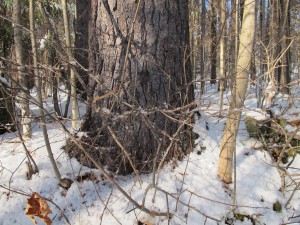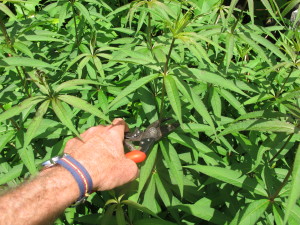Pinching? This Isn’t Kindergarten!
I was presenting at an outdoor gardening event recently when a woman walked by wearing a tee shirt that said, “No Pinching!” Maybe she had young kids, or was a kindergarten teacher. Clearly she was not an experienced gardener. Pinching plants is good, and now is the time to do it.
Let’s start with fruit trees. Many apple trees are loaded with small fruit now. Often there are 5 or more fruits together, especially at the tips of branches. If you pick off all but one or two fruits now, they will grow to a nice size. If you leave all the fruit on the tree, each fruit will be smaller. Not only that, you can often see what fruit is already damaged by insects and disease; it is smaller, and discolored. Removing that fruit will help the fruit you leave to be healthier. And eventually, you have to pick all the fruit anyway. It’s easier to do it now than in the fall. Leave the biggest, best looking fruit.
To thin fruit now, hold the cluster of small fruits in one hand, and pinch them off with the other. Holding the cluster helps to avoid breaking off the fruit spur and all the fruit on it. You can use pruning shears, but it is faster just to pinch (or pull) off the fruit. Don’t throw the fruit on the ground; it may be diseased or harbor insect pests, so you want to get rid of it. Come with plastic buckets and place them strategically around the tree as you work.
Work your way up the branch. Leave an apple or two every 8 inches. Michael Phillips, the author of two excellent books on growing organic apples, explains The Apple Grower: A Guide for in the Organic Orchardist (Chelsea Green Publishing, $40) that it is good to take all apples on alternating fruit spurs. This promotes a good harvest every year instead of a big harvest every other year, which is common on some varieties of trees. And remember, as you lament pulling off potential pies, that there is a limit to how many apples most of us can use.
I recently pinched off a bucket of blossoms from that terrible invasive weed known as goutweed or Bishops’s weed (Aegopodium podagraria). I have come to accept that I will never rid myself of this noxious pest, but I do believe I can limit its spread. It spreads quickly by root, which I limit with a lawnmower and some pulling. Seeds? From a reading of the literature, that they do not appear to be a primary means of dispersal. Still, in 15 minutes I can rid myself of the seeds, so I do. No point in taking chances.
When picking the goutweed flower heads, I ended up using my pruners, because with each flower, there is usually a lower, secondary flower cluster that is still developing under the shade of the leaves. I want to get both, so I reach down and snip off the stem lower down. Instead of tossing the flowers in the compost, I put them in the household trash that will go to the incinerator. A fitting demise for a devilish plant.
Annual flowers are coming in to bloom now, and pinching off spent flowers is important. I have some nice purple verbena growing in a window box by the front door. I often pause for a few moments and look at it to see if there are spent flowers. There always are, and I pinch them off. This stimulates the plant to set new buds. After all, it wants to make babies – and if an herbivore or a tidy gardener has removed its seeds, it needs to make more, starting with new flowers.
Not all annuals need to have their flowers pinched off. Some are called “self-cleaning”. They drop their flowers once they have finished blooming. Impatiens, begonias, and Euphorbias like ‘Diamond Frost’ are self-cleaning. Those that do need deadheading include annual bachelor buttons, gazanias, geraniums, marigolds, osteospurmums, pansies, pincushion flowers, salvias, snapdragons, sunflowers, verbenas and zinnias.
Another June task is to pinch or cut back tall summer- of fall-blooming perennials that you wish would stay shorter or bloom later. But you must do this now, or soon. It is fine to cut back these perennials when they are starting to form buds. The stems that you cut back – I recommend cutting off 4 to 6 inches – will have smaller flowers and often instead of 1 flower per stem, may have multiple blossoms.
I have already cut back my Culver’s root (Veronicastrum virginicum) and some of my bee balm (Monarda didyma). Both respond well to it. They bloom at a shorter height. My Culver’s root, if left alone, will often flop over –it can reach 4 to 5 feet in height. I cut back stems in a ring around the perimeter of the big clump, leaving just a few at full height in the middle. The lower stems help support the taller ones, and they bloom at different times.
There is a wonderful book by Tracy DiSabato-Aust, The Well-Tended Perennial Garden (Timber Press, $34.95) that nicely explains cutting back, and lists those perennials that respond well to it – and those that do not. She recommends cutting back asters, purple cone flower, Joe Pye weed, helenium, phlox, rudbekias and more.
So go ahead and pinch something. You’ll see it’s good –despite what you may have learned in kindergarten.
Henry is the author of 4 gardening books, and a children’s chapter book about a boy and a cougar, Wobar and the Quest for the Magic Calumet. His web site is www.Gardening-Guy.com.
Resolutions for 2014
On a sunny winter day I walked around my property and made a list of projects I should do in 2014. I knew I’d find a few, but easily found a dozen. Maybe these will encourage you to make your own resolutions for the upcoming year – or volunteer to come help me with mine!
In general I am pretty satisfied with my gardens. Yes, they always have some weeds – both in the vegetable garden and in my flower beds. I resolve to weed more in 2014, and, more importantly, to take my own advice and weed for at least a few minutes every day. Even 5 or ten minutes each day makes a big difference, I know it.
And there are some ‘vigorous’ plants that have taken over sections of some beds and need to be cleaned out or gotten under control. I resolve to work harder at doing so. I have some goutweed (Aegopodium podagraria) that has taken over a few places, and I know now that it is impossible to totally rid my gardens of it. Even if I were willing to use powerful chemical herbicides, which I am not, I cannot get rid of it. I will, however, work harder at keeping it contained. I will try to contain it with landscape fabric covered with bark mulch.

The small trees and shrubs growing round this large white pine will never be able to reach their full size. They will be shaded out and out-competed for water and soil nutrients.
I need to clear out young trees that are popping up around older trees. Trees drop seeds, and too many of those seeds germinate and start to grow – even if they are just a few inches from a mature tree. These babies crowd existing trees, and basically have no future. Instead of letting a young maple grow six inches from a mature pine tree, better to cut if off at the base. This is work that I can do now, before heavy snows fall. I can cut these fledglings off right at ground level.
It is time to add some limestone or wood ashes to my lawn around my maples. This is something I can do now. Maples suffer from the effects of acid rain: the much needed calcium in the soil gets dissolved and washes away. I have a few old sugar maples that are in poor health so I will give them a nice shot of calcium (in the form of wood ash) that I will spread around the trees. How much? I suppose I should get a soil test done and weigh out the quantity of ash according to a formula. But so long as I don’t add an excessive quantity, I feel a “good sprinkling” is fine.
I have two cedar structures that I built for supporting vines and both need some attention, which I resolve to give them in 2014. One is a simple entry way with a sloped “roof” that leads into my vegetable garden; it supports a clematis and a wisteria ‘Amethyst Blue’. The other is a hexagon with a tall teepee-like roof that supports a ‘Blue Moon’ wisteria and some grapes. The supporting structures are made from cedar fence posts (which last almost forever), but the thin branches of cedar I used for the roofs have started to rot and fall apart after 15 years or so. I was determined to make the repairs in 2013, but failed to do so.
I have some wetlands behind my stream that I have never utilized fully. The area is mostly grown up in willows and alders. This year I’d like to get rid of some of those, and plant more colorful shrubs: winterberry (Ilex verticillata), red- and yellow twigged dogwood (Cornus sericea) . I have planted some marsh marigolds in that area, but they are largely obscured. It’s time to clean out some of the volunteer growth. I want to keep it wild looking, not manicured, but I do love color in wintertime.
And speaking of willows, I have a willow that I planned to keep about 10 feet tall or so, but it has gotten to be more than twice that. I will do some radical pruning this year and next. One should never hack a tree back (I mean prune) more than 30% in a year, so I can’t do it all at once.
I have a Darwinian flower bed, one that I NEVER weed, one where only the fittest survive, but this coming year I resolve to do a little work there. The tall goldenrods, as much as I love them, have become too dominant. They are elbowing out the fall asters and a few other things. So I mowed the bed last fall, and will try to identify and dig up some of the goldenrods (Solidago spp.) in June. Maybe that will mean finding a young helper – or an intern – with a strong back to work with me.
I planted a spirea ‘Mellow Yellow’ in a dry shady place a few years ago after seeing one growing in a woodland garden in Lyme, NH. But mine has not developed the good color I saw there, so in 2014 I shall move it to a sunnier location. Shade comes in many varieties, and I think more sun will help this plant.
So that’s a good start with the garden resolutions. Send me yours, and if I get enough good suggestions, maybe I can do a column of reader resolutions. I’m at henry.homeyer@comcast.net or P.O. Box 364, Cornish Flat, NH 03746. I will only use first names, so don’t be bashful! Include the town where you live, please. And all my best to you for the New Year!
Henry Homeyer is the author of 4 gardening books. His web site is www.Gardening-Guy.com.





